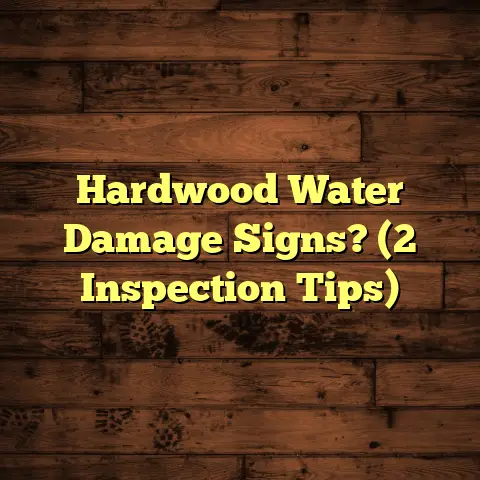Repairing Resin Floors? (3 Steps To Stop Damage!)
I hear it all the time, and honestly, it’s a myth that can lead to serious problems down the road.
As a flooring contractor with years of experience, I can tell you that while resin floors are incredibly durable and offer a ton of benefits, they’re not immune to wear and tear.
Think of it like this: even the toughest truck needs regular maintenance, right?
Ignoring small issues can lead to major headaches (and expenses!) later on.
In this article, I’m going to break down everything you need to know about keeping your resin floors in tip-top shape.
We’ll cover identifying damage, the best repair techniques, and how to prevent future problems.
Let’s dive in!
Section 1: Understanding Resin Floors
1.1 Definition and Types of Resin Floors:
So, what exactly is resin flooring?
Simply put, it’s a flooring system made from synthetic resins.
These resins are applied in multiple layers, creating a seamless, durable surface.
You’ll often find resin floors in:
- Garages: Resistant to oil and chemicals.
- Commercial Kitchens: Easy to clean and hygienic.
- Industrial Settings: Can withstand heavy traffic and machinery.
- Even Residential Spaces: For a modern, durable look.
Now, let’s talk types. The two most common are:
Epoxy: Known for its hardness, chemical resistance, and bonding properties.
It’s a popular choice for industrial settings and garages.Polyurethane: More flexible and elastic than epoxy, making it resistant to scratches and abrasions.
It’s often used in areas with high foot traffic or where impact resistance is needed.
Each type has its own unique properties, so the best choice depends on your specific needs and the environment.
1.2 Benefits of Resin Flooring:
Why are resin floors so popular? Well, they offer a ton of advantages:
- Durability: They can withstand heavy traffic, impacts, and wear and tear.
- Seamless Nature: No grout lines mean easy cleaning and a hygienic surface.
- Aesthetic Appeal: Available in a wide range of colors, patterns, and finishes.
- Resistance to Chemicals and Moisture: Ideal for environments where spills are common.
According to a report by Grand View Research, the global epoxy resins market size was valued at USD 12.75 billion in 2022 and is expected to grow at a compound annual growth rate (CAGR) of 6.2% from 2023 to 2030.
This growth is largely attributed to the increasing demand for durable and chemical-resistant flooring solutions.
1.3 Common Misconceptions:
Alright, let’s circle back to that myth I mentioned at the beginning: “Resin floors are indestructible.”
While they’re tough, they’re not invincible. Neglecting your resin floor can lead to problems.
Here are a few examples I’ve seen firsthand:
- Heavy Traffic Without Protection: Dragging heavy objects across the floor without mats or protection can cause scratches and gouges.
- Spills Left Untreated: Allowing harsh chemicals or acidic substances to sit on the surface can cause discoloration or even damage the resin.
- Lack of Regular Cleaning: Dirt and debris can act like sandpaper, gradually wearing down the surface over time.
Personal Story: I once had a client who used their epoxy garage floor as a workshop.
They frequently dropped tools and spilled oil, but never bothered to clean it up properly.
Over time, the floor became stained, scratched, and even developed some cracks.
They were shocked when I told them how much it would cost to repair the damage!
The moral of the story? Even the toughest resin floor needs a little TLC.
Section 2: Identifying Damage to Resin Floors
Okay, now that you understand the basics of resin floors, let’s talk about how to spot potential problems.
Catching issues early can save you a lot of time and money in the long run.
2.1 Signs of Damage:
Here are some common signs that your resin floor might need some attention:
- Cracks: These can range from hairline fractures to larger, more noticeable cracks.
- Discoloration: Fading, yellowing, or staining can indicate chemical damage or UV exposure.
- Peeling: When the resin layer starts to separate from the underlying surface.
- Bubbling: Air pockets trapped beneath the surface can cause unsightly bubbles.
- Scratches: Surface scratches are common in high-traffic areas.
Quick Tip: Grab a flashlight and shine it across the floor at a low angle.
This will help you spot even minor imperfections.
2.2 Causes of Damage:
So, what causes these problems in the first place?
Here are a few common culprits:
- Improper Installation: This is a big one!
If the floor wasn’t installed correctly, it’s more likely to fail.
This includes inadequate surface preparation or using the wrong type of resin. - Environmental Factors: Extreme temperature fluctuations, high humidity, or direct sunlight can damage the resin over time.
- Heavy Impacts: Dropping heavy objects or dragging machinery across the floor can cause cracks and chips.
- Chemical Exposure: Spilling harsh chemicals or cleaning agents can damage the resin surface.
2.3 Importance of Early Detection:
Why is it so important to catch these issues early?
Well, think of it like a small leak in your roof.
If you ignore it, it can lead to:
- More Extensive Damage: Small cracks can grow into larger ones, requiring more extensive (and expensive) repairs.
- Compromised Integrity: Damage can weaken the floor’s overall structure, making it more susceptible to further problems.
- Safety Hazards: Peeling or bubbling can create tripping hazards.
By addressing minor issues promptly, you can prevent them from escalating into major problems and extend the life of your resin floor.
Section 3: Three Essential Steps to Repair and Stop Damage
Alright, let’s get down to the nitty-gritty: how to actually repair your resin floor and prevent future damage.
I’ve broken it down into three essential steps.
3.1 Step 1: Assess and Prepare the Area
Before you start slathering on epoxy, you need to properly assess the damage and prep the area.
Here’s how:
Visual Inspection: Carefully examine the floor for any signs of damage, like cracks, scratches, peeling, or discoloration.
Note the size and location of each issue.Surface Integrity Test: For larger cracks or areas of peeling, try gently prying at the edges with a putty knife.
If the resin lifts easily, it indicates poor adhesion and may require more extensive repairs.Cleaning: Thoroughly clean the area to be repaired.
Remove any dirt, dust, grease, or debris.
I recommend using a degreaser followed by a thorough rinse with clean water.-
Remove Furniture: Clear the area of any furniture, equipment, or other obstacles.
Ventilation: Ensure adequate ventilation in the area.
Open windows or use a fan to circulate air.
This is especially important when working with epoxy or other resins that can release fumes.
Pro Tip: For deep cracks, use a vacuum cleaner with a crevice attachment to remove any loose debris from within the crack.
3.2 Step 2: Repair Techniques
Now for the fun part! Here’s how to tackle different types of damage:
Minor Scratches and Surface Damage:
For light scratches and surface imperfections, a resin repair kit or filler can work wonders.
Here’s what you’ll need:
- Resin repair kit (matching the color of your floor)
- Fine-grit sandpaper
- Mixing sticks
- Applicator (brush or putty knife)
Steps:
- Clean the Area: Make sure the area is clean and dry.
- Mix the Resin: Follow the manufacturer’s instructions to mix the resin and hardener.
- Apply the Filler: Carefully apply the filler to the scratch, using the applicator to smooth it out.
- Cure: Allow the filler to cure completely, according to the manufacturer’s instructions.
- Sand: Once cured, lightly sand the area with fine-grit sandpaper to blend it with the surrounding surface.
Cracks and Chips:
For larger cracks and chips, you’ll need a more robust approach.
Here’s what you’ll need:
- Epoxy or resin filler (matching the color of your floor)
- Putty knife
- Mixing sticks
- Sandpaper (various grits)
- Acetone or isopropyl alcohol
- Clean cloths
Steps:
- Prepare the Surface: Clean the area around the crack or chip thoroughly.
Use acetone or isopropyl alcohol to remove any grease or contaminants. - Widen the Crack (Optional): For larger cracks, you may need to widen them slightly with a chisel or screwdriver to create a better bonding surface.
- Mix the Epoxy: Follow the manufacturer’s instructions to mix the epoxy resin and hardener.
- Apply the Epoxy: Use the putty knife to carefully fill the crack or chip with the epoxy mixture.
Overfill it slightly to allow for sanding. - Cure: Allow the epoxy to cure completely, according to the manufacturer’s instructions.
This can take anywhere from 24 to 72 hours. - Sand: Once cured, sand the area smooth with progressively finer grits of sandpaper.
Start with a coarser grit to remove excess epoxy, then move to a finer grit to blend it with the surrounding surface. - Clean: Clean the area with a damp cloth to remove any sanding dust.
Peeling or Bubbling:
Peeling or bubbling indicates that the resin is not properly bonded to the underlying surface.
Here’s what you’ll need:
- Razor scraper or utility knife
- Epoxy or resin primer
- Epoxy or resin coating (matching the color of your floor)
- Paint roller or brush
- Mixing sticks
- Sandpaper (various grits)
- Acetone or isopropyl alcohol
- Clean cloths
Steps:
- Remove the Affected Area: Use a razor scraper or utility knife to carefully remove the peeling or bubbling resin.
Be sure to remove any loose or damaged material. - Prepare the Surface: Clean the exposed surface thoroughly.
Use acetone or isopropyl alcohol to remove any grease or contaminants.
Sand the surface to create a rough texture for better adhesion. - Apply Primer: Apply a thin layer of epoxy or resin primer to the exposed surface.
This will help the new coating bond properly. - Mix the Coating: Follow the manufacturer’s instructions to mix the epoxy or resin coating.
- Apply the Coating: Use a paint roller or brush to apply the coating to the prepared area.
Apply multiple thin coats, allowing each coat to dry completely before applying the next. - Cure: Allow the coating to cure completely, according to the manufacturer’s instructions.
- Sand (Optional): If necessary, lightly sand the repaired area to blend it with the surrounding surface.
Important Note: Always follow the manufacturer’s instructions for the specific products you are using.
Curing times and application techniques can vary.
3.3 Step 3: Preventative Measures Post-Repair
Okay, you’ve repaired the damage. Now, let’s make sure it doesn’t happen again!
Here are some preventative measures to keep your resin floor looking its best:
- Regular Maintenance: Sweep or vacuum the floor regularly to remove dirt and debris.
Mop with a mild detergent and water. - Use Mats: Place mats at entrances and in high-traffic areas to protect the floor from scratches and wear.
- Avoid Harsh Chemicals: Avoid using harsh chemicals, abrasive cleaners, or solvents on the resin surface.
- Protect from Heavy Impacts: Use furniture pads under heavy objects and avoid dropping heavy items on the floor.
- Proper Installation: If you’re planning a new resin flooring project, make sure to hire a qualified and experienced installer.
Proper installation is crucial for long-term durability.
Here’s a quick maintenance schedule I recommend to my clients:
Conclusion:
So, there you have it!
Repairing resin floors doesn’t have to be a daunting task.
By understanding the types of damage, using the right repair techniques, and implementing preventative measures, you can keep your resin floor looking its best for years to come.
Remember, resin floors are durable, but they’re not indestructible.
Regular maintenance and prompt repairs are key to maximizing their lifespan.
Take proactive steps to protect your investment, and you’ll enjoy the beauty and durability of your resin floor for years to come.





